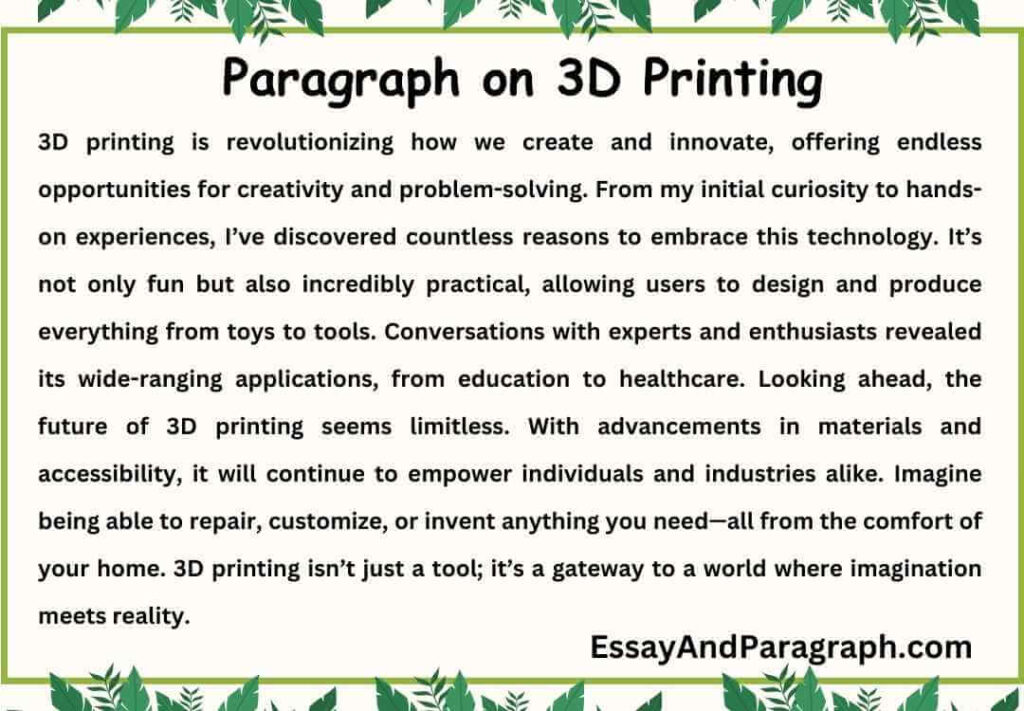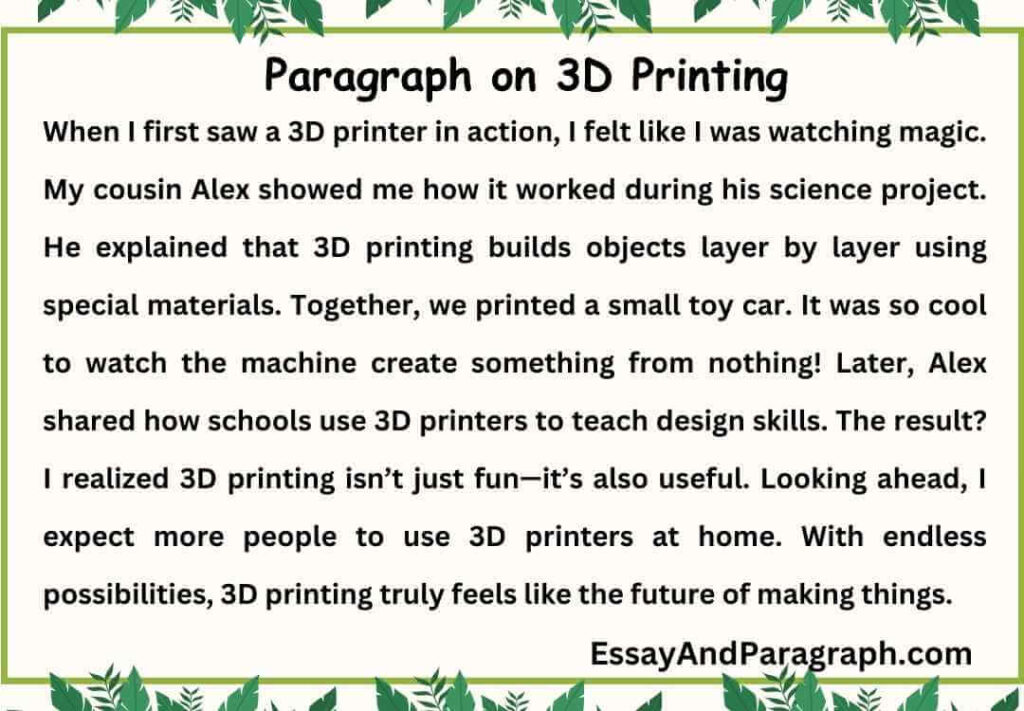Have you ever imagined creating your own toys, tools, or even parts for broken gadgets right at home? That’s the magic of 3D printing ! When I first heard about it, I was amazed by how this technology turns ideas into real objects. As someone who loves exploring new inventions, I’ve spent time learning and experimenting with 3D printers myself. In this article, we will learn how to write paragraphs on 3D printing in different lengths (100, 150, 200, 250, 300 words). Whether you’re curious about how it works or excited to try it yourself, this guide is here to help. Let’s dive into the fascinating world of 3D printing together!
Paragraph on 3D Printing [100 words]
When I first saw a 3D printer in action, I felt like I was watching magic. My cousin Alex showed me how it worked during his science project. He explained that 3D printing builds objects layer by layer using special materials. Together, we printed a small toy car. It was so cool to watch the machine create something from nothing! Later, Alex shared how schools use 3D printers to teach design skills. The result? I realized 3D printing isn’t just fun—it’s also useful. Looking ahead, I expect more people to use 3D printers at home. With endless possibilities, 3D printing truly feels like the future of making things.

Paragraph on 3D Printing [150 words]
The first time I learned about 3D printing, I thought it sounded too futuristic to be real. To understand better, I visited my friend Mia, who owns a small 3D printer. She invited me to her workshop, where she was printing phone cases. “It’s like drawing in layers,” she said, showing me how the printer followed a digital design. We spent hours chatting while the machine worked its magic.
Later, Mia introduced me to her online community of 3D printing enthusiasts. They shared tips on designing models and choosing materials. One member even printed custom prosthetics for kids! These interactions inspired me to think bigger about 3D printing’s potential. By the end of the day, I understood why it’s gaining popularity. Not only does it spark creativity, but it also solves real-world problems. In the future, I believe 3D printing will become as common as smartphones. Its ability to create anything makes it truly revolutionary.
Paragraph on 3D Printing [200 words]
When I first tried 3D printing, I couldn’t believe how simple yet powerful it was. At a local tech fair, I met Sam, an expert who demonstrated how 3D printers build objects layer by layer. He let me design a tiny keychain using easy software. Watching the printer bring my idea to life felt incredible—it was like watching a pencil draw in three dimensions!
Afterward, I joined a group discussion with other visitors. A teacher named Lisa explained how her students used 3D printers to make prototypes for science fairs. Another participant, Tom, talked about repairing household items by printing replacement parts. Their stories showed me how versatile 3D printing can be.
What amazed me most was how accessible it has become. Affordable desktop printers now allow anyone to start creating at home. By the end of the fair, I realized 3D printing isn’t just for professionals—it’s for everyone. From art projects to medical innovations, its applications are limitless.
Looking forward, I’m excited to see how 3D printing evolves. With faster machines and stronger materials, the possibilities will grow even further. Whether it’s building homes or crafting personalized gifts, 3D printing is paving the way for a creative and innovative future.
Paragraph on 3D Printing [250 words]
My fascination with 3D printing began when I attended a hands-on workshop last summer. At first, I wasn’t sure what to expect, but the instructor, Rachel, quickly put me at ease. She explained that 3D printing transforms digital designs into physical objects, one layer at a time. Her enthusiasm made me eager to try it myself.
I started by designing a miniature house using beginner-friendly software. Rachel guided me through the process, helping me adjust settings like size and material type. Once the design was ready, we sent it to the printer. As the nozzle moved back and forth, I marveled at how precise and steady it was. Within an hour, my little house stood complete—a tangible reminder of what 3D printing could achieve.
During breaks, I chatted with other participants. One man, Joe, shared how he uses 3D printing to create custom tools for his business. Another woman, Priya, told me about printing educational models for her classroom. Their experiences highlighted the practical side of this technology.
By the end of the workshop, I felt inspired. Seeing how diverse and impactful 3D printing can be reassured me of its importance. Governments and companies are already investing in large-scale applications, like constructing buildings and producing medical devices. In the next decade, I imagine 3D printers becoming essential tools in every home and workplace. With their ability to turn imagination into reality, 3D printers represent the ultimate blend of creativity and innovation.
Paragraph on 3D Printing [300 words]
When I first encountered 3D printing, I admit I had doubts. Could it really live up to the hype? Determined to find out, I signed up for a weekend course hosted by a local tech center. There, I met Ben, a passionate instructor who walked us through the basics. His excitement about 3D printing was contagious, and soon I found myself diving into the process.
One highlight was learning about filament types—materials like PLA and ABS that determine an object’s strength and flexibility. Ben demonstrated how to load the filament and set up a print job. For my first project, I designed a small figurine using free modeling software. As the printer hummed along, layering plastic into shape, I felt a mix of wonder and pride.
Afterward, I mingled with fellow students. Sarah, a hobbyist, showed off earrings she’d designed and printed herself. Another attendee, David, discussed how he repaired his bike by printing a missing part. Hearing their stories reinforced the versatility of 3D printing.
What struck me most was the sense of empowerment it brought. Anyone with access to a 3D printer could create solutions tailored to their needs. By the end of the course, I realized 3D printing wasn’t just about technology—it fostered creativity and problem-solving.
Reflecting on the experience, I see immense potential for 3D printing. Innovators are already exploring advanced uses, like bioprinting organs and constructing affordable housing. As costs decrease and capabilities improve, I foresee widespread adoption in homes, schools, and industries. With its ability to transform ideas into reality, 3D printing embodies progress. It’s not just reshaping manufacturing—it’s inspiring us to dream bigger and build smarter.
FAQs on 3D Printing
What Is 3D Printing?
3D printing is a process that creates three-dimensional objects by adding layers of material based on a digital design. It’s widely used in industries like healthcare, education, and manufacturing.
How Does 3D Printing Work?
A 3D printer reads a digital file and deposits material layer by layer until the object is complete. Common materials include plastics, metals, and resins.
Is 3D Printing Expensive?
While industrial-grade printers can be costly, affordable desktop models are available for beginners. Many schools and libraries also offer access to shared printers.
What Can You Make With a 3D Printer?
You can create almost anything—from toys and jewelry to tools and prosthetics. The only limit is your imagination and the printer’s capabilities.
Where Can You Learn About 3D Printing?
Online tutorials, workshops, and courses are great ways to learn. Websites like YouTube and platforms like Tinkercad provide beginner-friendly resources.
Why Should You Try 3D Printing?
Trying 3D printing sparks creativity, teaches valuable skills, and opens doors to solving everyday problems. It’s a hands-on way to explore innovation.
Summary on 3D Printing
3D printing is revolutionizing how we create and innovate, offering endless opportunities for creativity and problem-solving. From my initial curiosity to hands-on experiences, I’ve discovered countless reasons to embrace this technology. It’s not only fun but also incredibly practical, allowing users to design and produce everything from toys to tools. Conversations with experts and enthusiasts revealed its wide-ranging applications, from education to healthcare. Looking ahead, the future of 3D printing seems limitless. With advancements in materials and accessibility, it will continue to empower individuals and industries alike. Imagine being able to repair, customize, or invent anything you need—all from the comfort of your home. 3D printing isn’t just a tool; it’s a gateway to a world where imagination meets reality.




